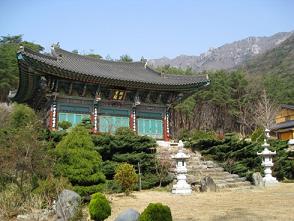Seven Korean monasteries seek UNESCO World Heritage
by Emi Hailey Hayakawa, BTN, Aug 29, 2012
Seoul, South Korea -- The Presidential Council on Nation Branding began its research and investigation for the application of the UNESCO World Heritage Site at 7 monasteries in Korea.
 << Tongdosa Monastery, eyeing as UNESCO World Heritage site
<< Tongdosa Monastery, eyeing as UNESCO World Heritage site
The seven monasteries includes Beopjusa Monastery, Tongdosa Monastery, Buseoksa Monastery, Bonjeongsa Monastery, Magoksa Monastery, Seonamsa Monastery, and Daehungsa Monastery. All of these monasteries boast a history of over 1000 years and various important historical and cultural assets within their domain.
The Council met on August 10th at the Ministry of Cultural Assets for a meeting regarding the strategies for the application of the UNESCO World Heritage Site at the 7 monasteries in Korea.
The Presidential Council on Nation Branding began its research and propulsion for the application of the UNESCO World Heritage Site after President Lee Myung Bak attended the council meeting in 2011 and emphasized the importance of traditional folk culture heritage. Thus, in April and May of 2012, the Council created the Specialist Council and began having meetings regarding the application of UNESCO World Heritage Site for various gardens and monasteries.
On July 26th 2012 the Council announced the open applications for various enterprises in the planning and operation and PR for the Academic Forum, and the closing date will be on October 15th 2012. During these dates, there will be major planning for the Academic Forum to further inform the public regarding the importance and historic assets of the 7 pre-elected monasteries.
Beobjusa monastery stated that they have created and is currently propulsing an operations committee for the preparations of the application of the UNESCO World Heritage Site along with the Ministry of Cultural Assets and the Jogye Order of Korean Buddhist.
Beopjusa temple currently holds the National treasure 55, the Palsangjeon Hall of Beopjusa temple, and 15 other National treasures and 300 Buddhist cultural assets. Adjacent to the temple, there is various hermitages, cliffs, etc which makes this temple both historically and naturally important.
In Tongdosa monastery, otherwise known as the Buddhist jewel temple, lays National treasure 290, the Daeungjeon Hall and stairs of Tongdosa temple, and holds 19 other treasures.
Seonamsa monastery holds National treasure 400, the beautiful Seungseon bridge and 15 other important treasures.
BongJeongsa monastery has the oldest wooden buliding Geungnakjeon Hall of Bongjeongsa temple, otherwise known as National Treausure 15, and other important architectures that are national cultural assets. They also have an important rock carving of the Maitreya and is said to be the most important national rock carving.
Buseoksa is said to have the most beautiful wooden structure, the Muryangsujeon Hall of Buseoksa Temple, otherwise known as National treasure 18, and Seated clay Buddha statue of Buseoksa temple (National treasure 45).
Additionally Wall painting in Josadang Hall of Buseoksa temple (National treasure 46) and Josadang Hall of Buseoksa temple (National treasure 19) and boasts of other treasures and cultureal assets.
Magoksa temple holds various Buddhist cultural assets such as the Daeungbo Hall (treasure 801) and Daeheungsa temple is mostly known for North rock-cut seated Maitreya buddha of Daeheungsa Temple designated National treasure 308.
Thus, there will be an Academic Forum in further informing of the various national treasures, cultural assets, and Buddhist assests of the 7 monasteries, and its' historical, cultural, and Buddhist importance, and will lead to the UNESCO making its designation in December of 2012.
Read More @ Source
Comments
Post a Comment